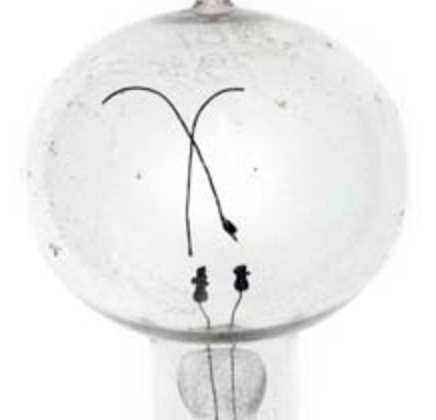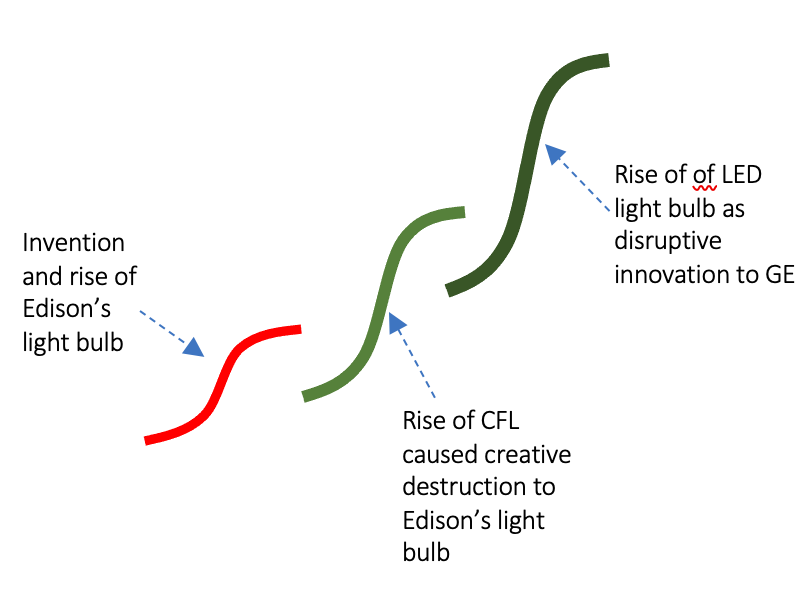On New Year’s Eve, 1879, at Edison’s Menlo Park, N.J., laboratory, Edison’s light bulb went for public demonstration. Among a record 1,093 patents, the light bulb is his most famous invention. Edison’s light bulb created light by passing an electric current through carbon filament, heating it enough to glow. For protecting the hot filament from the air, it was placed inside an inert gas-filled glass bulb. Despite numerous previous attempts by many others, including Edison himself, this was the first practical electric incandescent lamp. Subsequently, on January 27, 1880, Thomas Edison received patent number US223,898A for his incandescent light bulb. However, despite a remarkable success, this invention suffered from a Creative Destruction effect, and Edison’s company GE suffered from the effect of Disruptive Innovation.
A long journey of tinkering led to Edison’s light bulb:
Inventors relied on the trial and error method to figure out which one worked in those days. Hence, Edison’s 10,000 unsuccessful attempts before reaching the state of demonstrating his light bulb invention were no surprise. Later on, his saying that he succeeded in proving those 10,000 ways would not work became famous.
However, Edison was not the first to invent the incandescent light bulb. In 1840, British scientist Warren de la Rue developed a light bulb by electrically heating a coiled platinum filament. But due to the high cost of platinum, it did not succeed in diffusing. Among others, Volta also demonstrated a glowing wire. Some inventors who experimented with commercially impractical light bulbs are Humphry Davy, James Bowman Lindsay, Moses G. Farmer, William E. Sawyer, Joseph Swan, and Heinrich Göbel.

Hence, in 1878, Edison embarked on experimentation with electrical illumination. Unlike past attempts of demonstration, the objective was to come up with something to compete with gas and oil-based lighting. His mission was to find a long-lasting incandescent lamp that would be a strong substitute for existing means of lighting for indoor use. To succeed in his endeavor, he had three major problems to solve: (i) low-cost filament, (ii) long life span, and (iii) low energy consumption. Hence, he got into a vigorous investigation into possible candidate filaments. One of the notable candidates was a carbonized filament of uncoated cotton. Edison’s team produced a light bulb out of it by October 1979, but it could last for 14.5 hours only. Eventually, he settled upon finding a carbonized bamboo filament that could last over 1,200 hours, in 1879. Subsequently, commercial manufacturing began in 1880.
Commercialization of Edison’s light bulb:
In his mission of making Edison’s light bulb so cheap that only the rich would burn candles, he assigned the commercialization work of his invention to Edison Electric Light Company (renamed GE later on). Despite many controversies, Edison’s light bulb started gaining popularity in Europe as well. In 1882 in the Czech Republic, the first public building in the world used Edison’s electric lamps.
Incremental advancement race:
Soon after the release of Edison’s light bulb in the market, his company faced two major problems. The light bulb’s life should be extended further to increase the sale. The next one was the response from the competition, particularly from Europe. For example, in 1882, in Germany, Cruto’s lamp was found more efficient than Edison’s light bulb. Besides, it produced a better, white light. Upon realizing that further advancement needed systematic investigation, he set up GE’s corporate R&D lab in 1999. Among many improvements of Edison’s light bulb, in 1906, GE patented a method of making tungsten filaments for use in incandescent lightbulbs. Even after 40 years of invention, Edison’s light bulb was wasting as high as 90 percent energy despite many incremental advancements. Hence, a journey started for finding an alternative method of producing light more efficiently.
Creative destruction from CFL:
One of the candidate technologies for reducing energy wastage of Edison’s light bulb was a fluorescent lamp. It was invented in the late 1890s by Peter Cooper Hewitt. GE’s R&D team’s work on finding a cost-effective fluorescent lamp version led to spiral CFL in 1976. However, GE did not commercialize it due to high capital investment need, about $25 million to build new factories. Subsequent development led to making CFL a better alternative to the incandescent lamp. CFL emerged four times more energy efficient that could last ten times longer. Price also sharply fell. Hence, by the 1990s, Edison’s light bulb started to experience the creative destruction effect from CFL. For example, by 2011 in China, CFL became the dominant lighting option in the residential segment. However, GE did not suffer from destructive effects due to its lead and continuation in CFL’s invention and commercialization.
LED caused disruptive innovation effect to GE:
Another candidate technology for having light in a more efficient way was a light-emitting diode (LED). GE’s Nick Holonyak invented it in 1962 by demonstrating visible red light from the LED. However, the development of LED light bulbs to replace energy-hungry incandescent ones faced a significant barrier. Having a blue LED for getting white light faced almost an insurmountable obstacle.
Among many others, Japan’s Nichia sponsored basic research to overcome it. Fortunately, Nichia succeeded in inventing perfect white light. Due to the high scientific barrier, GE and others could not keep space with Nichia. With a 25,000–35,000 hours life span, far more efficient LED light bulbs started to emerge as a better alternative to incandescent and CFL light bulbs. By 2018, LED took over India’s 60 percent lighting market. Eventually, as opposed to GE, Nichia became the world’s best-LED chip producer. Hence, upon suffering from the disruptive innovation effect out of LED, GE lost its century-old lead-in lighting.
Evolution and migration of the light bulb: making inventor importer
For sure, Edison’s the light bulb is a great invention. It began the journey of electric lighting for indoor usages. Its commercialization seeded the growth of mighty GE. Although incremental advancement kept improving the life span, efficiency, and quality, incandescent technology faced the limit. Hence, GE’s invention CFL emerged as a better alternative—causing creative destruction effect to Edison’s light bulb. But after almost 100 years of reign, GE suffered from the disruptive innovation effect from LED, as GE lost the edge to Nichia’s invention out of Nobel Prize-winning scientific discovery. Subsequently, the rise of Nichia’s might as the world’s best-LED chip maker has tuned America as the importer of the core technology of light bulbs, which it invented.
...welcome to join us. We are on a mission to develop an enlightened community by sharing the insights of Wealth creation out of technology possibilities as reoccuring patters. If you like the article, you may encourage us by sharing it through social media to enlighten others.




